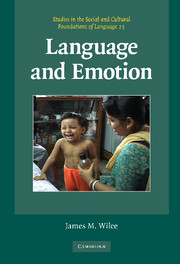Book contents
- Frontmatter
- Contents
- List of figures
- List of transcripts
- Acknowledgements
- Introduction
- Part I Theory
- Part II Language, power, and honor
- Part III Identification and identity
- Part IV Histories of language and emotion
- 9 A history of theories
- 10 Shifting forms of language and emotion
- 11 Language and the medicalization of emotion
- 12 Conclusion
- Notes
- Glossary
- References
- Index
- STUDIES IN THE SOCIAL AND CULTURAL FOUNDATIONS OF LANGUAGE
10 - Shifting forms of language and emotion
Published online by Cambridge University Press: 05 June 2012
- Frontmatter
- Contents
- List of figures
- List of transcripts
- Acknowledgements
- Introduction
- Part I Theory
- Part II Language, power, and honor
- Part III Identification and identity
- Part IV Histories of language and emotion
- 9 A history of theories
- 10 Shifting forms of language and emotion
- 11 Language and the medicalization of emotion
- 12 Conclusion
- Notes
- Glossary
- References
- Index
- STUDIES IN THE SOCIAL AND CULTURAL FOUNDATIONS OF LANGUAGE
Summary
Introduction: historical problems
The titles of this and the previous chapter entertain the illusion that “theory” (in focus in Chapter 9) belongs to academe, and is somehow distinct from “the world,” which occupies us in this chapter. But this book has presented ‘culture,’ ‘language,’ and ‘emotion’ as moving targets whose existence in the world is inseparable from dominant theories. Neither ‘a language’ nor ‘synchronic’ linguistic ‘facts’ are fixed entities, or explicable apart from history. This includes apparent facts about any particular language-emotion nexus in any particular population. Because cultural ideologies of mind and language are in a constant state of flux, we can expect significant changes as centuries pass. Note the stark contrast between two cultural discourses on emotion in two declarations from British courts across four centuries: “The thought of man is not triable; the devil alone knoweth the thought of a man” (1477), and (from 1889) “The state of a man's mind is as determinable as the state of his digestion.” (Rosen 1995: 5).
Later in this chapter I describe early modern transformations that shook English society, but let me start with more familiar, recent events. Linguistic, emotional, and social change has certainly accelerated. We can hardly miss changes in communication that are going on around us, brought about by or accompanying the use of technology. Insofar as it appears to be creating phenomena like the intimate stranger, mobile phone use, at least in Japan, may be socio-emotionally significant (Miller 2006: 1051). Email, chat, and instantmessaging are famous as channels for the evolving use of new emotional lexemes, so to speak – emoticons.
- Type
- Chapter
- Information
- Language and Emotion , pp. 153 - 167Publisher: Cambridge University PressPrint publication year: 2009



